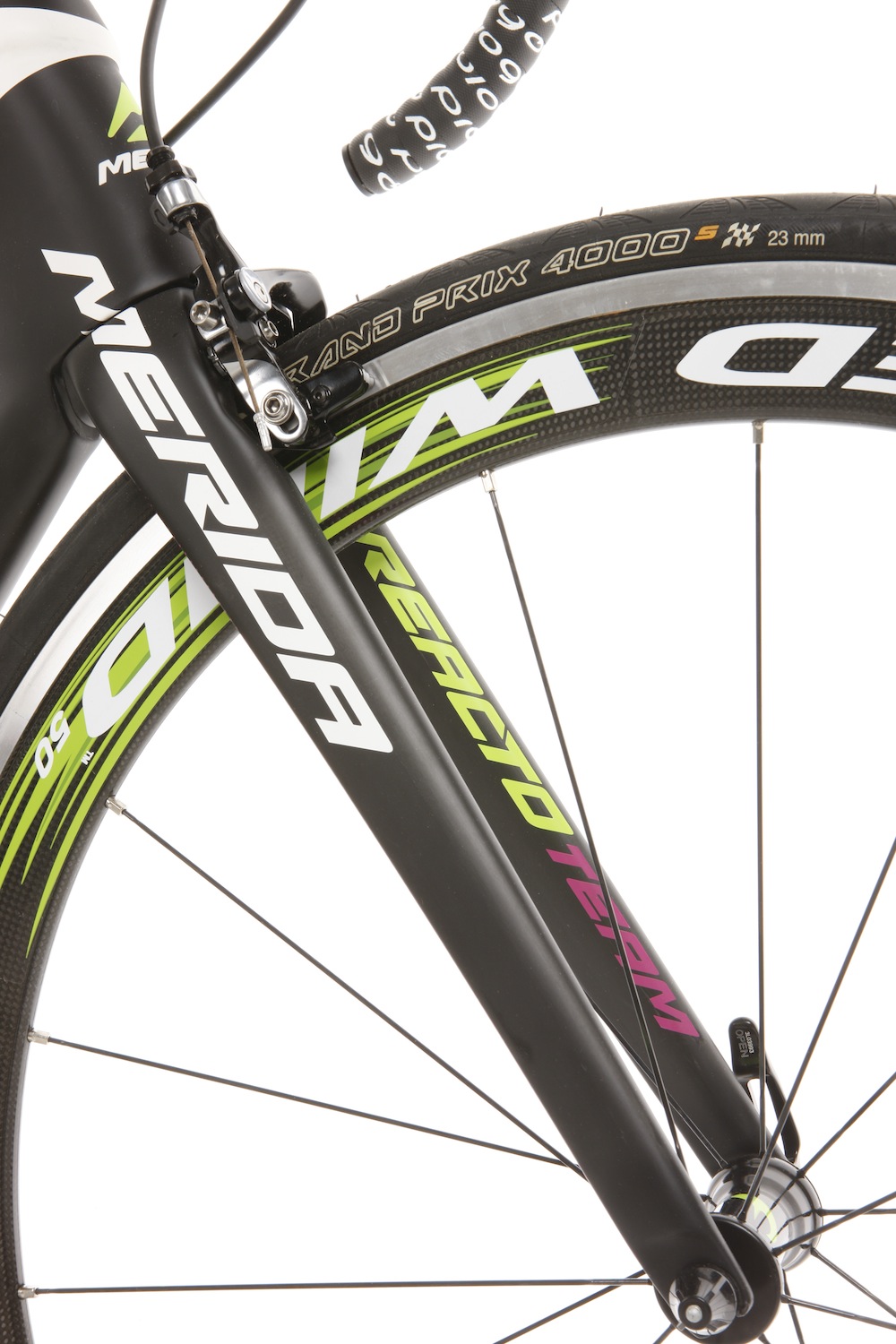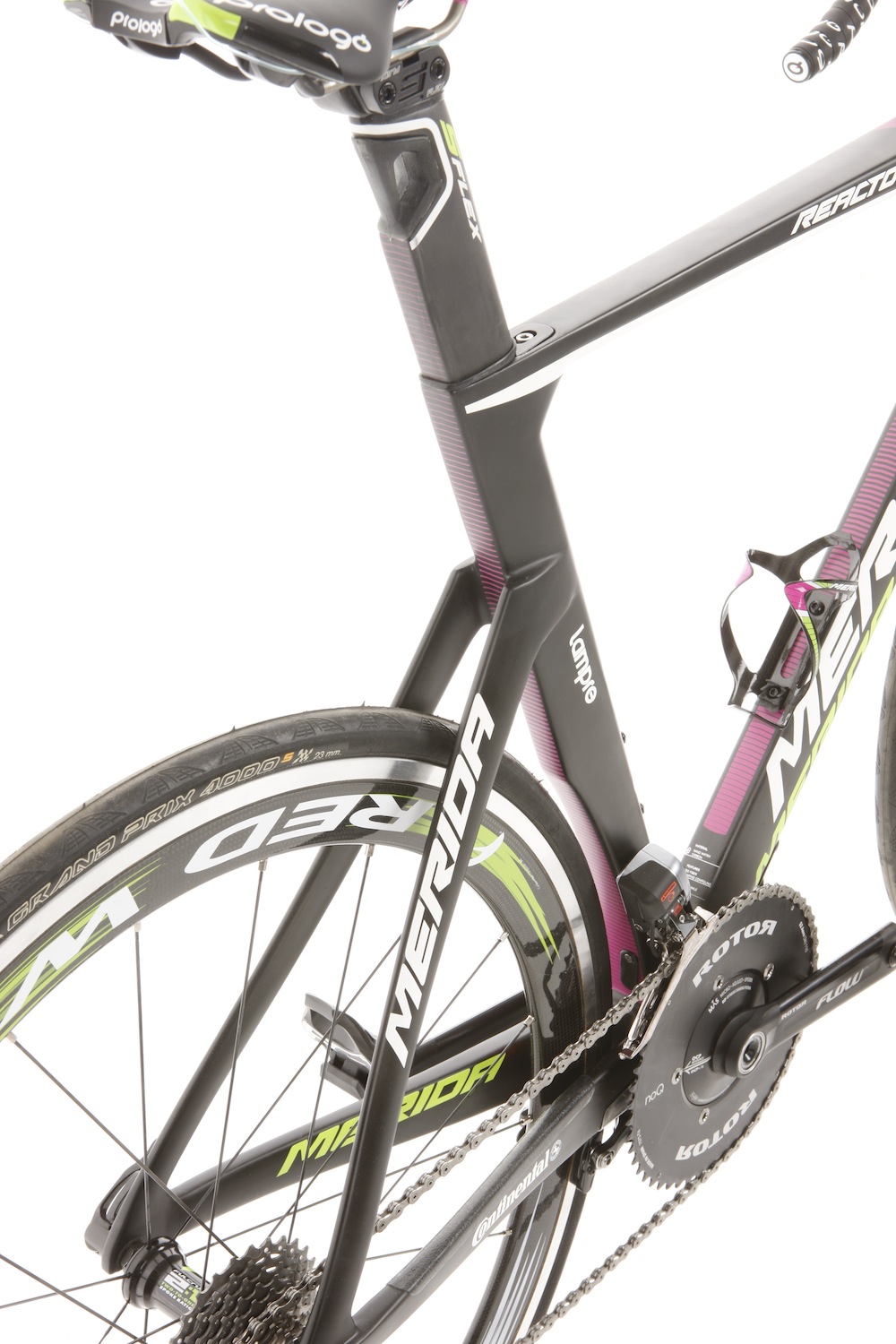Merida Reacto Team E review
The Merida Reacto Team E is same frame as used by the Lampre Pro Team. Cycling Weekly has put it through its paces to see how it stacks up against the competition

The frame is certainly ‘more’; it is just a shame that it doesn’t come with ‘more’ wheels.
-
+
Supremely stiff frame
-
+
Noticeably fast
-
+
Stunning looks
-
+
Impressive comfort
-
+
Excellent brakes
-
-
Wheels too heavy
-
-
Wheels suffer in cross winds
-
-
Wheels not stiff enough
-
-
Expensive
-
-
23mm tyres
You can trust Cycling Weekly.
If you watched any road cycling coverage last year, there is a good chance you saw the Merida Reacto Team E in a very prolific advert featuring a comedically dubbed Rui Costa riding in Majorca describing it as “M.O.R.E. bike”. And so the obvious question arises: is the top-of-the-range model from the Taiwanese brand actually ‘more’ bike?
>>> Canyon Aeroad CF SLX bike review
You may not realise, but Merida is actually Taiwan's second largest bicycle manufacturer. This is the bike that has been used by the Lampre Merida Pro team since 2014. Although, they will use lighter, tubular wheels than the alloy/carbon clinchers supplied on this version.
The stats do point to this being 'more bike.' In 2012 the Lampre team did not score any victories, but with the Reacto in 2014 they scored 14 victories. Is this in part down to using a superior bike?

The Groupset
Being a top-end machine the Merida Reacto Team E comes kitted with Dura-Ace Di2, which provided flawless gear changes. Front mech shifting on the Rotor Flow chainset worked very well too, with no dropped chains throughout the test period. We really like the Shimano Dura-Ace direct-mount brakes, which offer superior stopping power and modulation over the standard single-mount calliper.
>>> Fabian Cancellara's custom Classics bike
The latest race content, interviews, features, reviews and expert buying guides, direct to your inbox!
We have had the pleasure of testing these on other bikes, such as the Canyon Aeroad CF SLX. The difference here though, is that the rear brake is mounted on the bottom bracket, in an effort to reduce drag.

Riders often complain of maintenance issues with bottom bracket mounted brakes, but I had no issues. During the test period, I rode the Reacto through Winter, with the bike getting caked in salt and mud on multiple occasions.
>>> For a complete guide to group sets, click here
I cleaned the bike regularly, but if you are the kind of rider who doesn't have either the time or inclination to clean your bike often then issues may arise. Aerodynamics aside, not having the rear brake mounted on the stays results in a very tidy and striking rear end that is incredibly stiff.

The wheels are Fulcrum Red Wind C50s. I am not sure about the look of these wheels, on a bike that is already strewn with logos everywhere you look, but they no doubt provide some aero benefit. They are however heavy, weighing a reported 1755g a pair. Adorning the weighty wheels are the ever reliable and top performing Continental GP4000s.

The chainset is a Rotor Flow with NoQ, meaning that the rings are round and not ovalised. However, there is the option to add Q-rings to the Rotor cranks if you want to. The Rotor Flow cranks suggest that no stone has been left unturned in the hope for aero gains. Rotor claim that the Flow cranks can give a 26.4 second advantage when averaging 200W over 180km. For those amongst you who are not regular players of Countdown, that is 0.14 seconds per kilometre. Marginal gains!
The Frame
According to Merida, the Reacto is marginally less aerodynamic than the Cervelo S5 at 45kph, 0.94% to be precise. However they claim that the Reacto is a superior package owing to its much greater comfort and flex. The S5 has been critised in the past for having a harsh ride and this is a common flaw in aero road bikes.
S-FLEX seat post and Bio Fibre Dampening
The added comfort is claimed to come from a number of technologies. Firstly there is the S-Flex seat post. The rubber insert is designed to compress and flex, taking the buzz out of the road. The idea is that by allowing flex here, it does not compromise bottom bracket stiffness. The carbon layup also features natural flax fibres.
Merida have found that inclusion of flax fibres in the carbon structure of the seat, chain stays and fork blades reduces high-frequency vibrations. It appears to work, with the Reacto offering a commendably comfortable ride for such a stiff frame.

The seat clamp is also neatly integrated into the top tube, to further add to the aero credentials of this frame. All the cables are integrated and the strange silver object under the handle bars is the quick release for the rear brake. In case you were wondering, the Di2 battery is neatly hidden inside the seat post.

Geometry
The geometry of this bike is aggressive. The top tube is long and will encourage the rider to adopt a low and aero position. Our size 54cm test bike comes up large and is similar to a 56cm frame in many other bikes. The stack is 559mm and the reach is 400mm. By comparison, the reach in a 54cm Specialized Venge is 386mm. The geometry suggests this is an out and out race machine and at the time of writing, there are only limited sizes available – 52cm, 54cm, 56cm.

Weight
Our size 54cm tips the Cycling Weekly scales at 7.54 kg without pedals. By substituting the saddle for one with carbon rails and switching the wheels to some lightweight DT-Swiss 38mm tubs, I dropped the complete bike weight, with Ultegra pedals to 7.00 Kg. Consider that the UCI weight limit is 6.8kg. The Fulcrum wheels certainly add quite a lot of weight, with the bike weighing an impressive 4.76kg without them. We think this is very respectable for an aero bike, although it is slightly heavier than the Cervelo S5.
Riding
Appearances can be deceptive, with the Merida Reacto Team E frame looking almost identical to the slightly more affordable £3,500 Reacto DA Ltd. However, with regard to the ride, these bikes are poles apart, and the difference really is staggering. The Team E is not just lighter, it also feels a lot stiffer in both the frame and fork.
Owing to a different carbon lay-up, this bike feels like the bike the DA Ltd wants to be. The bottom bracket and fork are supremely stiff, making accelerating out of corners and sprinting noticeably efficient. The rear triangle of the Team E is among the stiffest I have ever ridden — to the extent I had an issue with the rear brake rubbing on the wheel when out the saddle. This was highly annoying, but was resolved when I substituted the Fulcrums for a pair of Mavic Cosmic Carbones.

Changing the wheels also dramatically improved the ride, reducing weight, adding cross-wind stability and easing harshness. Using 25mm tyres further improved comfort; it was a surprise to see Merida buck the wider tyre trend with a set of Continental 23mm.
For such a very stiff frame, the Reacto Team E is commendably comfortable and has been a pleasure on rides as long as 100 miles. Let’s not get carried away, though; you certainly wouldn’t want it for cobbles or rough surfaces. By way of a comparison it is substantially more comfortable than the current Cervelo S5.
Value
This premier league bike is competing with the big guns — the Pinarello F8, Cervélo S5, Giant Propel, S-Works Venge and Canyon Aeroad. The problem is that for £5,899 you can purchase a Canyon Aeroad with full Di2 Dura-Ace, integrated aero handlebar and Zipp 404 wheels. While we prefer the comfort and stiffness of the Merida, the Canyon knocks it for six on value — so much so, it would be hard to justify the extra outlay.

Verdict
If I were on the Lampre Merida Team, I would be delighted to be riding the Team E. It is a superb bike that instantly feels fast the first time you hop on it. It’s an out-and-out race machine that loves to attack and even feels at home on climbs. The frame is superb, but the wheels that come with the bike let it down, especially considering the £7,000 price tag.
They are not stiff enough, are too heavy and suffer badly in cross winds. Regarding the weight, by changing to a carbon-railed saddle and mid-section tubular wheels, I reduced the bike to 7kg — so if you are looking for a super-light climbing bike, look elsewhere. The frame is certainly ‘more’; it is just a shame that it doesn’t come with ‘more’ wheels.
For more information head over to Merida.
Oliver Bridgewood - no, Doctor Oliver Bridgewood - is a PhD Chemist who discovered a love of cycling. He enjoys racing time trials, hill climbs, road races and criteriums. During his time at Cycling Weekly, he worked predominantly within the tech team, also utilising his science background to produce insightful fitness articles, before moving to an entirely video-focused role heading up the Cycling Weekly YouTube channel, where his feature-length documentary 'Project 49' was his crowning glory.